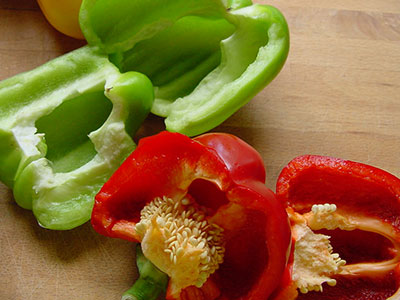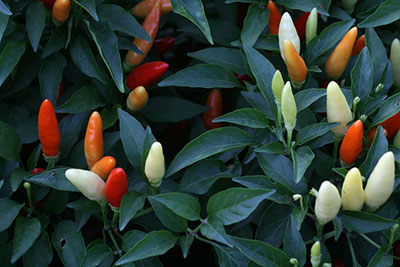Peppers
Peppers are a popular vegetable to grow in Florida and with such a wide variety of choices it’s no wonder.

There are tiny peppers grown solely for ornamentation, sweet bell peppers, and hot chilies, like St. Augustine’s famous datil peppers.
Bell peppers are the most commonly grown. These sweet peppers are an excellent source of vitamins and add beautiful colors to your garden and table. Often harvested while green, bell peppers can also be left on the plant to ripen further to become red, yellow, orange, or brown, depending on the variety. Fully ripened peppers are sweeter than those harvested while still green.
Hot peppers get their spicy flavor from a compound known as capsaicin and the relative spiciness of peppers is compared on a heat index known as the Scoville scale. Milder peppers like Anaheims or jalapenos rank between 1,000 and 10,000 Scoville units, while spicier peppers like the cayenne or habanero can check in at 50,000 or 250,000 Scoville units. Learn more about these spicy varieties in our Gardening Solutions article on hot peppers.
Even if you don’t plan on eating them, hot peppers can still be fun to grow. Their colorful fruits can be red, purple, yellow, or orange and they easily add interest to landscape beds and containers. In fact, some pepper varieties like ‘Black Pearl’, ‘Calico’, ‘Purple Flash’, and ‘Sangria’ are grown almost exclusively for their ornamental value.
Ornamental peppers are compact, only reaching ten to twenty inches in height and produce colorful fruits from May through fall. Many varieties of ornamental pepper also have attractive foliage.
Despite their name, some ornamental peppers are edible. But many are very spicy, and people without a sturdy palate might want to simply enjoy them for their beauty.
Planting and Care

You can buy pepper transplants or you can start your own from seed. If you’re interested in trying some of the more exotic varities, you may need to order seeds online.
If starting plants from seed, it’s recommended that you start indoors, as the small seeds are easily washed away during watering in the garden. Seeds planted indoors can be started in late winter for planting after the last frost in spring. Peppers can be started again in midsummer for an early fall planting in August and September.
The spacing of your pepper plants will depend on the variety, so be sure to check the spacing requirements. As your plants grow and fruits begin to weigh them down, staking can help keep them upright.
Like other vegetables, peppers should be planted in full sun and will thrive in well-drained fertile soil. While peppers are not too particular, they do best in soil with a pH around 6.5. Pepper plants prefer moist, but not wet, soil. Watering regularly will keep your plants producing fruits. Mulching will help hold moisture in as temperatures rise.
Fertilize your peppers at the time of planting, and again two to three times throughout the growing season. You can also use a controlled-release fertilizer for season-long feeding. Once plants begin to produce fruits, reduce the amount of nitrogen in your fertilizer — too much nitrogen in the soil can cause peppers to produce fewer fruits.
Harvesting Peppers
Peppers will be ready to harvest once they’re firm and crisp, about 60 to 80 days after transplanting (80 to 100 after planting seed). You can harvest bell peppers while they are green, or leave fruits on the plant to ripen further. Use caution when handling hot pepper varieties. The same properties that give these peppers their flavorful heat can also cause painful irritation in eyes and on skin.
Choose Florida-Friendly Varieties
There are a number of pepper varieties to choose from, so take care to select plants that will grow well in Florida’s unique climate. ‘California Wonder’, ‘Red Knight’, and ‘Big Bertha’ are a varieties of bell peppers that grow well in Florida gardens. Other sweet peppers suited for Florida include ‘Sweet Banana’, ‘Giant Marconi’, ‘Mariachi’, and ‘Cubanelle’.
If you are more interested in growing hot peppers, try the jalapeno varieties ‘Early Jalapeno’ or ‘Jalapeno M’. There are many specialty hot peppers suited for our climate. We suggest several varieties in our Gardening Solutions article on hot peppers.
For more information on growing peppers, contact your county Extension office.
